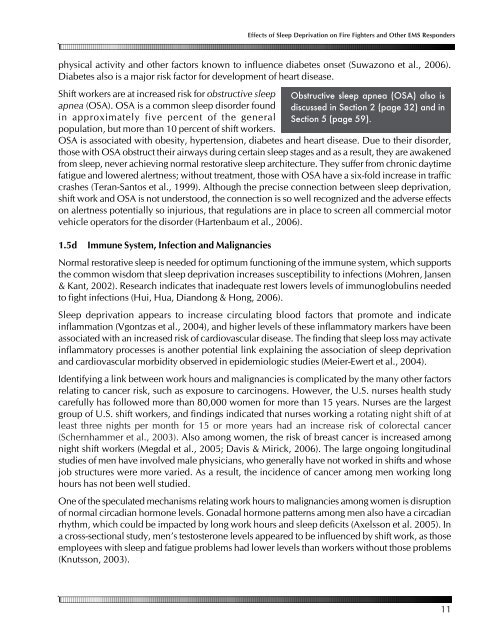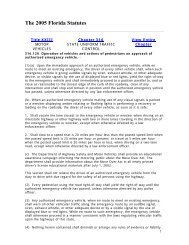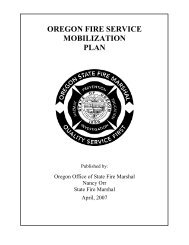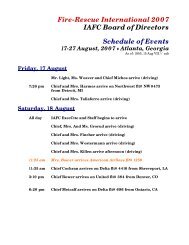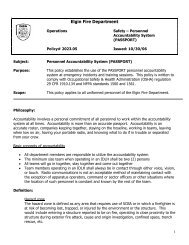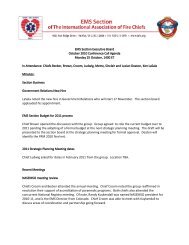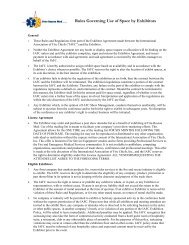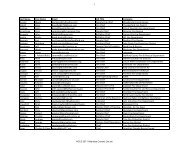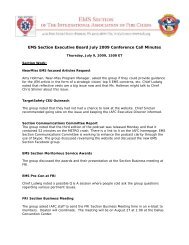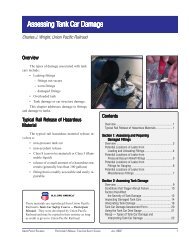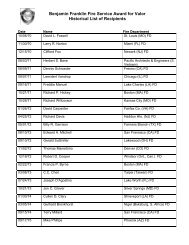Effects of Sleep Deprivation on Fire Fighters and EMS ... - NAEMT
Effects of Sleep Deprivation on Fire Fighters and EMS ... - NAEMT
Effects of Sleep Deprivation on Fire Fighters and EMS ... - NAEMT
You also want an ePaper? Increase the reach of your titles
YUMPU automatically turns print PDFs into web optimized ePapers that Google loves.
<str<strong>on</strong>g>Effects</str<strong>on</strong>g> <str<strong>on</strong>g>of</str<strong>on</strong>g> <str<strong>on</strong>g>Sleep</str<strong>on</strong>g> <str<strong>on</strong>g>Deprivati<strong>on</strong></str<strong>on</strong>g> <strong>on</strong> <strong>Fire</strong> <strong>Fighters</strong> <strong>and</strong> Other <strong>EMS</strong> Resp<strong>on</strong>ders<br />
physical activity <strong>and</strong> other factors known to influence diabetes <strong>on</strong>set (Suwaz<strong>on</strong>o et al., 2006).<br />
Diabetes also is a major risk factor for development <str<strong>on</strong>g>of</str<strong>on</strong>g> heart disease.<br />
Shift workers are at increased risk for obstructive sleep<br />
apnea (OSA). OSA is a comm<strong>on</strong> sleep disorder found<br />
in approximately five percent <str<strong>on</strong>g>of</str<strong>on</strong>g> the general<br />
populati<strong>on</strong>, but more than 10 percent <str<strong>on</strong>g>of</str<strong>on</strong>g> shift workers.<br />
OSA is associated with obesity, hypertensi<strong>on</strong>, diabetes <strong>and</strong> heart disease. Due to their disorder,<br />
those with OSA obstruct their airways during certain sleep stages <strong>and</strong> as a result, they are awakened<br />
from sleep, never achieving normal restorative sleep architecture. They suffer from chr<strong>on</strong>ic daytime<br />
fatigue <strong>and</strong> lowered alertness; without treatment, those with OSA have a six-fold increase in traffic<br />
crashes (Teran-Santos et al., 1999). Although the precise c<strong>on</strong>necti<strong>on</strong> between sleep deprivati<strong>on</strong>,<br />
shift work <strong>and</strong> OSA is not understood, the c<strong>on</strong>necti<strong>on</strong> is so well recognized <strong>and</strong> the adverse effects<br />
<strong>on</strong> alertness potentially so injurious, that regulati<strong>on</strong>s are in place to screen all commercial motor<br />
vehicle operators for the disorder (Hartenbaum et al., 2006).<br />
1.5d Immune System, Infecti<strong>on</strong> <strong>and</strong> Malignancies<br />
Obstructive sleep apnea (OSA) also is<br />
discussed in Secti<strong>on</strong> 2 (page 32) <strong>and</strong> in<br />
Secti<strong>on</strong> 5 (page 59).<br />
Normal restorative sleep is needed for optimum functi<strong>on</strong>ing <str<strong>on</strong>g>of</str<strong>on</strong>g> the immune system, which supports<br />
the comm<strong>on</strong> wisdom that sleep deprivati<strong>on</strong> increases susceptibility to infecti<strong>on</strong>s (Mohren, Jansen<br />
& Kant, 2002). Research indicates that inadequate rest lowers levels <str<strong>on</strong>g>of</str<strong>on</strong>g> immunoglobulins needed<br />
to fight infecti<strong>on</strong>s (Hui, Hua, Di<strong>and</strong><strong>on</strong>g & H<strong>on</strong>g, 2006).<br />
<str<strong>on</strong>g>Sleep</str<strong>on</strong>g> deprivati<strong>on</strong> appears to increase circulating blood factors that promote <strong>and</strong> indicate<br />
inflammati<strong>on</strong> (Vg<strong>on</strong>tzas et al., 2004), <strong>and</strong> higher levels <str<strong>on</strong>g>of</str<strong>on</strong>g> these inflammatory markers have been<br />
associated with an increased risk <str<strong>on</strong>g>of</str<strong>on</strong>g> cardiovascular disease. The finding that sleep loss may activate<br />
inflammatory processes is another potential link explaining the associati<strong>on</strong> <str<strong>on</strong>g>of</str<strong>on</strong>g> sleep deprivati<strong>on</strong><br />
<strong>and</strong> cardiovascular morbidity observed in epidemiologic studies (Meier-Ewert et al., 2004).<br />
Identifying a link between work hours <strong>and</strong> malignancies is complicated by the many other factors<br />
relating to cancer risk, such as exposure to carcinogens. However, the U.S. nurses health study<br />
carefully has followed more than 80,000 women for more than 15 years. Nurses are the largest<br />
group <str<strong>on</strong>g>of</str<strong>on</strong>g> U.S. shift workers, <strong>and</strong> findings indicated that nurses working a rotating night shift <str<strong>on</strong>g>of</str<strong>on</strong>g> at<br />
least three nights per m<strong>on</strong>th for 15 or more years had an increase risk <str<strong>on</strong>g>of</str<strong>on</strong>g> colorectal cancer<br />
(Schernhammer et al., 2003). Also am<strong>on</strong>g women, the risk <str<strong>on</strong>g>of</str<strong>on</strong>g> breast cancer is increased am<strong>on</strong>g<br />
night shift workers (Megdal et al., 2005; Davis & Mirick, 2006). The large <strong>on</strong>going l<strong>on</strong>gitudinal<br />
studies <str<strong>on</strong>g>of</str<strong>on</strong>g> men have involved male physicians, who generally have not worked in shifts <strong>and</strong> whose<br />
job structures were more varied. As a result, the incidence <str<strong>on</strong>g>of</str<strong>on</strong>g> cancer am<strong>on</strong>g men working l<strong>on</strong>g<br />
hours has not been well studied.<br />
One <str<strong>on</strong>g>of</str<strong>on</strong>g> the speculated mechanisms relating work hours to malignancies am<strong>on</strong>g women is disrupti<strong>on</strong><br />
<str<strong>on</strong>g>of</str<strong>on</strong>g> normal circadian horm<strong>on</strong>e levels. G<strong>on</strong>adal horm<strong>on</strong>e patterns am<strong>on</strong>g men also have a circadian<br />
rhythm, which could be impacted by l<strong>on</strong>g work hours <strong>and</strong> sleep deficits (Axelss<strong>on</strong> et al. 2005). In<br />
a cross-secti<strong>on</strong>al study, men’s testoster<strong>on</strong>e levels appeared to be influenced by shift work, as those<br />
employees with sleep <strong>and</strong> fatigue problems had lower levels than workers without those problems<br />
(Knutss<strong>on</strong>, 2003).<br />
11


